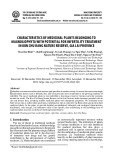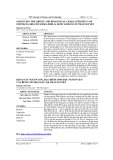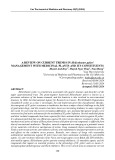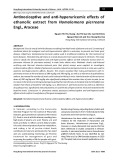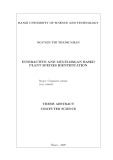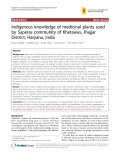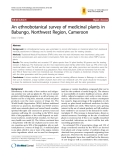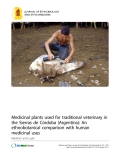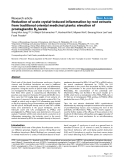
Annocicepve and an-hyperuricemic effects of ethanolic extract from Homalomena pierreana Engl., Araceae*Nguyen Thi Thu Huong , Bui Thi Que Chi, Cao Dinh Khoi, Nguyen Mai Linh and Tran Hoang Kha HanHong Bang Internaonal University, VietnamABSTRACTBackground: Gout is one of arthris diseases resulng from high levels of plasma uric acid. Screening of medicinal plants for analgesic and an-hyperuricemic effects is necessary to prevent and treat gout disease. Objecves: Homalomena has been widely used in tradional medicine for the treatment of bone diseases. Homalomena pierreana is a newly discovered rare species found in Vietnam. The study aims to clarify the annocicepve and an-hyperuricemic effects of 45% ethanolic extract from H. pierreana rhizome (H. pierreana extract) in male Swiss albino mice. Methods: Acec acid-induced writhing and thermal smulus-induced pain (hot plate) assays were applied to invesgate annocicepve effects. Model of potassium oxonate-induced acute hyperuricemia in mice was used to examine an-hyperuricemic effects. Results: The results revealed that 5-day pretreatment with H. pierreana extract at the oral doses of 390 mg/kg and 780 mg/kg, as well as a reference drug diclofenac sodium, decreased the number of acec acid-induced writhing in mice. Administraon of the extract at doses of 390 mg/kg and 780 mg/kg also significantly delayed the reacon me of mice to pain (or an increase in the latency to licking/jumping) caused by thermal smulus in hot plate test but the effect was weaker than those of morphine (10 mg/kg, i.p.). Moreover, H. pierreana extract as well as a reference drug allopurinol, significantly reduced plasma uric acid levels of hyperuricemic mice and restored to the baseline levels. Conclusion: H. pierreana extract possesses annocicepve and an-hyperuricemic effects which confirm its usefulness of the gout management.Keywords: Homalomena pierreana rhizome, annocicepve effect, an-hyperuricemic effectIn Vietnam, according to the Community Oriented Program for the Control of Rheumac Diseases, gout prevalence is about 0.14% in Hanoi [1]. Gout is one of arthris disease resulng from high levels of plasma uric acid. Plasma uric acid levels are likely to reflect current dietary habits. Uric acid is the end product of purine metabolism, and eang a lot of purine-riched foods contributes to total uric acid levels [2]. Pain relief and uric acid-lowering monitoring are first-line treatment for management of gout and improving the quality of life for people with gout. Besides drug therapy, adjusng dietary habits and using natural products from medicinal plants help to prevent and minimize the risk of gout.Homalomena has been widely used in tradional medicine for the treatment of rheumasm and bone diseases. Homalomena pierreana Engl., Araceae is a newly discovered rare species that has been referenced in studies conducted in Vietnam recently. H. pierreana [another name: Homalomena griffithii (Scho) Hook. f.] was idenfied by Van Hong Thien et al. by DNA barcode sequence in 2020 [3]. This plant had some research publicaons on its 51Hong Bang Internaonal University Journal of ScienceISSN: 2615 - 9686 DOI: hps://doi.org/10.59294/HIUJS.VOL.6.2024.629Hong Bang Internaonal University Journal of Science - Vol.6 - 6/2024: 51-58Corresponding author: Assoc. Prof. Dr Nguyen Thi Thu HuongEmail: huongntt1@hiu.vn1. INTRODUCTION





